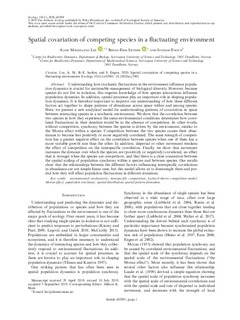| dc.contributor.author | Lee, Aline Magdalena | |
| dc.contributor.author | Sæther, Bernt-Erik | |
| dc.contributor.author | Engen, Steinar | |
| dc.date.accessioned | 2020-01-29T12:30:37Z | |
| dc.date.available | 2020-01-29T12:30:37Z | |
| dc.date.created | 2020-01-09T12:33:11Z | |
| dc.date.issued | 2020 | |
| dc.identifier.citation | Ecology. 2019, 101 (1) | nb_NO |
| dc.identifier.issn | 0012-9658 | |
| dc.identifier.uri | http://hdl.handle.net/11250/2638608 | |
| dc.description.abstract | Understanding how stochastic fluctuations in the environment influence population dynamics is crucial for sustainable management of biological diversity. However, because species do not live in isolation, this requires knowledge of how species interactions influence population dynamics. In addition, spatial processes play an important role in shaping population dynamics. It is therefore important to improve our understanding of how these different factors act together to shape patterns of abundance across space within and among species. Here, we present a new analytical model for understanding patterns of covariation in space between interacting species in a stochastic environment. We show that the correlation between two species in how they experience the same environmental conditions determines how correlated fluctuations in their densities would be in the absence of competition. In other words, without competition, synchrony between the species is driven by the environment, similar to the Moran effect within a species. Competition between the two species causes their abundances to become less positively or more negatively correlated. The same strength of competition has a greater negative effect on the correlation between species when one of them has a more variable growth rate than the other. In addition, dispersal or other movement weakens the effect of competition on the interspecific correlation. Finally, we show that movement increases the distance over which the species are (positively or negatively) correlated, an effect that is stronger when the species are competitors, and that there is a close connection between the spatial scaling of population synchrony within a species and between species. Our results show that the relationships between the different factors influencing interspecific correlations in abundance are not simple linear ones, but this model allows us to disentangle them and predict how they will affect population fluctuations in different situations. | nb_NO |
| dc.language.iso | eng | nb_NO |
| dc.publisher | John Wiley & Sons | nb_NO |
| dc.rights | Navngivelse 4.0 Internasjonal | * |
| dc.rights.uri | http://creativecommons.org/licenses/by/4.0/deed.no | * |
| dc.title | Spatial covariation of competing species in a fluctuating environment | nb_NO |
| dc.type | Journal article | nb_NO |
| dc.type | Peer reviewed | nb_NO |
| dc.description.version | publishedVersion | nb_NO |
| dc.source.volume | 101 | nb_NO |
| dc.source.journal | Ecology | nb_NO |
| dc.source.issue | 1 | nb_NO |
| dc.identifier.doi | 10.1002/ecy.2901 | |
| dc.identifier.cristin | 1769299 | |
| dc.relation.project | Norges forskningsråd: 223257 | nb_NO |
| dc.relation.project | Norges forskningsråd: 244647 | nb_NO |
| dc.description.localcode | © 2019 The Authors. Ecology published by Wiley Periodicals, Inc. on behalf of Ecological Society of America This is an open access article under the terms of the Creative Commons Attribution License, which permits use, distribution and reproduction in any medium, provided the original work is properly cited. | nb_NO |
| cristin.unitcode | 194,66,10,0 | |
| cristin.unitname | Institutt for biologi | |
| cristin.ispublished | true | |
| cristin.fulltext | original | |
| cristin.qualitycode | 2 | |

